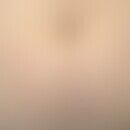Synonym(s)
HistoryThis section has been translated automatically.
Wagner 1866
DefinitionThis section has been translated automatically.
Circumscribed connective tissue disorder with deposition of a "defective" scleroprotein (colloid) in the papilla tips of light-exposed skin areas.
You might also be interested in
ClassificationThis section has been translated automatically.
Four variants have been described:
- By age of manifestation:
- Juvenile colloid milium (see below colloid milium, juvenile)
- Adult, classic colloid milium
- Pigmented colloid milium (with exogenous ochronosis)
- Nodular colloid milium (paracolloid)
EtiopathogenesisThis section has been translated automatically.
Adult or solar form: more common form, especially with chronic exposure to light or after contact with photosensitizers. Occurs in adulthood. It is caused by degeneration of elastic fibers in response to chronic UV exposure.
Juvenile form (rare): occurring before puberty. Not triggered by light exposure! Autosomal dominant and autosomal recessive mode of inheritance known (BültmannL et al. 2022). Genetic defect as yet unknown.
Pigmented form in exogenous ochronosis. Topical hydroquinone and phenols are discussed etiologically in this variant (Rajagopal V et al. 2021).
Nodular form: rare variant of the adult form.
ManifestationThis section has been translated automatically.
- Adult or solar form: more common form, especially with chronic exposure to light or after contact with photosensitizers. Occurs in adulthood.
- Juvenile form (rare): occurring before puberty. Autosomal dominant mode of inheritance
- Pigmented form with exogenous ochronosis. Aetiologically, topical hydroquinone and phenols are discussed in this variant (Rajagopal V ete al.
- Nodular form
LocalizationThis section has been translated automatically.
ClinicThis section has been translated automatically.
HistologyThis section has been translated automatically.
Homogeneous, circumscribed, amophilic or basophilic, PAS-positive colloidal conglomerates in the upper dermis. The deposits are cell-poor. Typical are the preparation-related cracks and fissures within the colloid nodule. The overlying epithelium is flattened and atrophic. In the adult form, solar elastosis is obligatory, which is missing in the juvenile form. Versch. Investigators could stain the (keratin-)colloid with keratin-AK in the juvenile form (compare keratin-amlyoid in LIchen amyloidosus)
Indirect immunofluorescenceThis section has been translated automatically.
Differential diagnosisThis section has been translated automatically.
TherapyThis section has been translated automatically.
Diathermy, laser therapy with Erbium-YAG laser, photodynamic therapy, curettage or cryosurgery.
Dermabrasion has been tried.
Topical retionoids have also been used, but with little success.
Note(s)This section has been translated automatically.
Noteworthy is the reference to the concordant occurrence of beta-thalassaemia major and colloid milium (Giordano G et al. 2008).
LiteratureThis section has been translated automatically.
- Ammirati CT et al. (2002) Adult-onset facial colloid milium successfully treated with the long-pulsed Er:YAG laser. Dermatol Surg 28: 215-219
- Bültmann L et al.(2024) Skin-colored, asymptomatic papules since adolescence. JDDG 22: 1445-1447
- Chowdhury MM et al. (2000) Juvenile colloid milium associated with ligneous conjunctivitis: report of a case and review of the literature. Clin Exp Dermatol 25: 138-140
- Giordano G et al. (2008) A case of colloid milium in patient with beta thalassaemia major. J Cutan Pathol 35:566-569.
- Kirtak N et al. (2002) A case of adult colloid milium with chronic sun exposure. Int J Dermatol 41: 936-938
- Lewis AT et al. (2002) Unilateral colloid milium of the arm. J Am Acad Dermatol 46(2 Suppl Case Reports): S5-7
Macedo-Pérez M et al (2022) Adult colloid milium. Actas Dermosifiliogr. 114:166.
- Muscardin LM et al. (2000) Papuloverrucous colloid milium: an occupational variant. Br J Dermatol 143: 884-887
- Oskay T et al. (2003) Juvenile colloid milium associated with conjunctival and gingival involvement. J Am Acad Dermatol 49: 1185-1188
- Rajagopal V ete al. (2021) Skin-colored papules and infiltration on sun-exposed skin in an elderly woman. J Dtsch Dermatol Ges 19:1359-1362)
- Schuster V et al (2003) Ligneous conjunctivitis. Surv Ophthalmol 48: 369-388
- Schrallhammer-Benkler K et al (1990) Colloid milium. Dermatology 41: 451-454
Incoming links (9)
Colloidmilium juveniles; Degeneration, colloidal; Degeneration of the skin, colloidal; Elastosis colloidalis conglomerata; Hyalom; Lipoid proteinosis; Milia; Pseudomilium colloidale; Pseudoxanthoma elasticum;Outgoing links (18)
Adenoma sebaceum; Amyloidosis (overview); Cheilitis actinica (overview); Colloidmilium juveniles; Cryosurgery; Curettage; Cutis rhomboidalis nuchae; Dermabrasion; Elastoidosis cutanea nodularis et cystica; Erbium yag laser; ... Show allDisclaimer
Please ask your physician for a reliable diagnosis. This website is only meant as a reference.







